Syphilis epidemiology and demographics
Editor-In-Chief: C. Michael Gibson, M.S., M.D. [1] Associate Editor(s)-in-Chief: Aysha Anwar, M.B.B.S[2]; Nate Michalak, B.A.
|
Syphilis Microchapters | |
|
Diagnosis | |
|
Treatment | |
|
Case Studies | |
|
Syphilis epidemiology and demographics On the Web | |
|
American Roentgen Ray Society Images of Syphilis epidemiology and demographics | |
|
Risk calculators and risk factors for Syphilis epidemiology and demographics | |
Overview
In 2012, the incidence of syphilis was estimated to be 6 million cases worldwide. From year 2005 to 2014, the incidence of syphilis in the United States increased from 2.9 to 6.3 cases/100,000/year. The rate of reported cases increased by 15.1% between 2013 and 2014 in the United States.[1] Syphilis incidence increased in every region of the Untied States in 2014, with the highest rate in the West and lowest rate in the Midwest. In 2012, the prevalence of syphilis was estimated to be approximately 18 million cases in men and women aged 15-29 worldwide.[2] The incidence and prevalence of syphilis may be affected by age, gender, race, sexual behavior and geographical distribution.[1][3][4][5][6][7]
Epidemiology
Incidence
- Worldwide incidence of syphilis:
- Incidence of syphilis in the United States:
- From 2005 to 2014, the incidence of primary and secondary syphilis increased from 2.9 to 6.3 cases/100,000/year.
- From 2009 to 2014, the incidence of late and latent syphilis increased from 5.6 to 7.4 cases/100,000/year.
- The rate of reported cases increased by 15.1% between 2013 and 2014.[1]
- Syphilis incidence increased in every region of the Untied States in 2014, with the highest rate in the West and lowest rate in the Midwest.

Prevalence
- In 2008, the prevalence of syphilis was estimated to be 36.4 million cases worldwide.[9]
- In 2012, the prevalence of syphilis is estimated to be 18 million cases in men and women aged 15-29 worldwide.[2]
- In 2014, the prevalence of syphilis in the United States was estimated to be 20 cases/100,000 individuals.[1]
Demographics
The incidence and prevalence of syphilis may be affected by the following demographic factors:[1][4]
Age
In 2014, the highest rate of primary and secondary syphilis in the United States was seen in age groups 20-24 years and 25-29 years.[1][3]
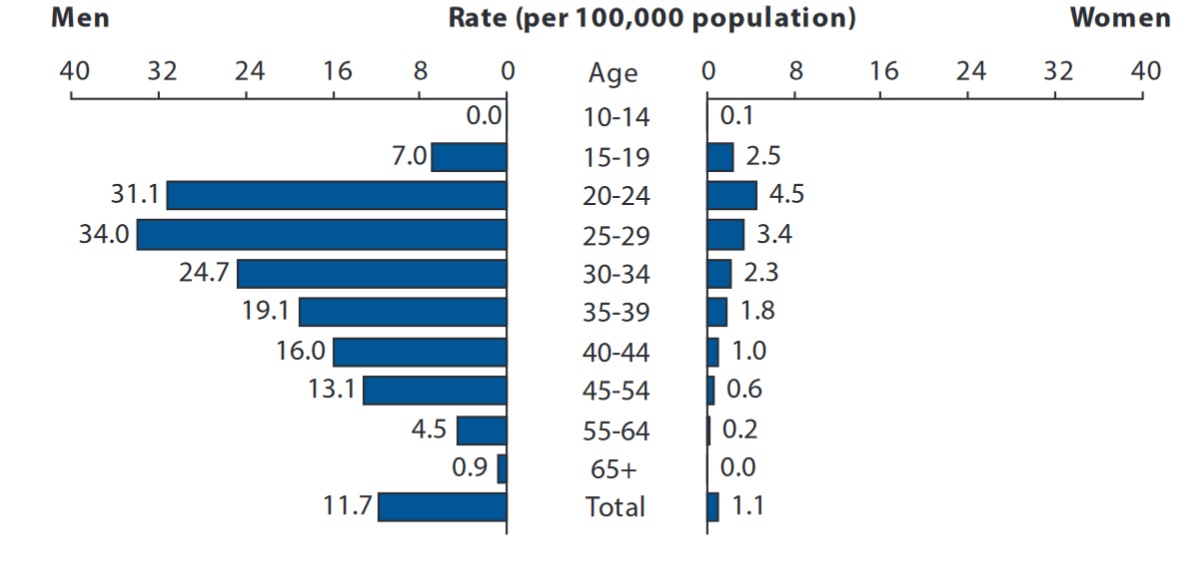
Gender
- There is increased incidence of primary and secondary syphilis in men who have sex with men (MSM).
Primary and Secondary Syphilis — Reported Cases by Stage, Sex, and Sexual Behavior, 2014
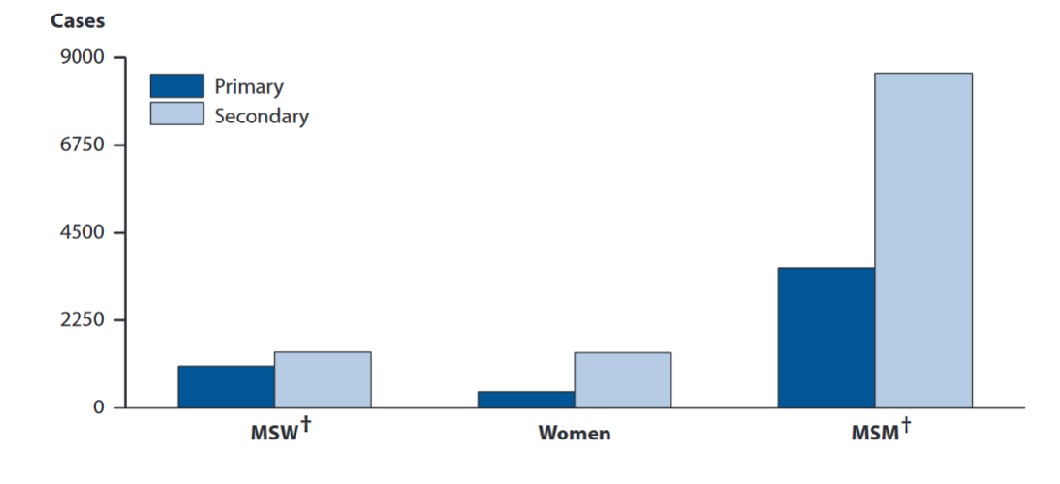
Race
- Syphilis is more prevalent in the African American population as compared to other racial groups.[2]
- In 2014, the highest incidence of primary and secondary syphilis in the United States was reported to be in the African American population and the lowest incidence was observed in Caucasisans, Asians and multiracial groups.[1]
Primary and Secondary Syphilis — Reported Cases by Sex, Sexual Behavior, and Race/Ethnicity, United States, 2014
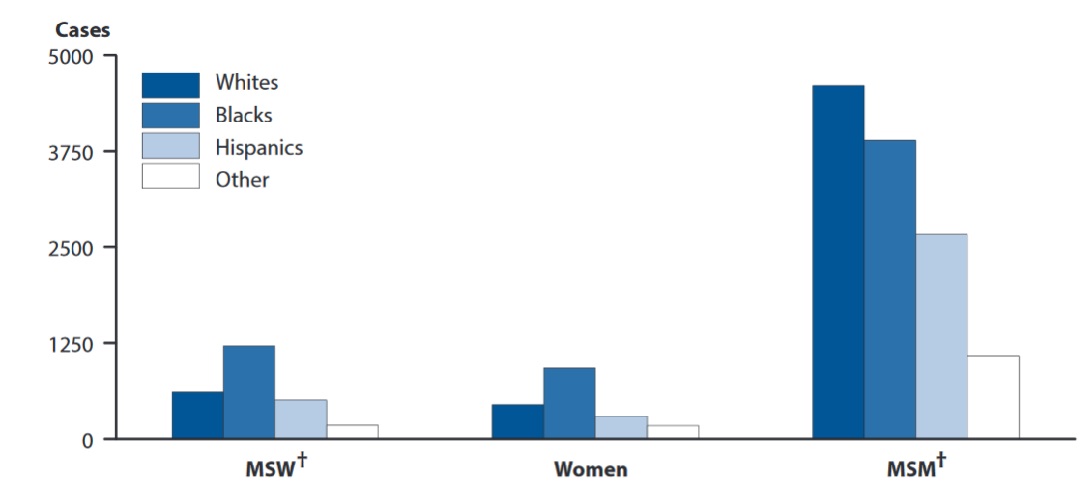
Geographical distribution
Worldwide, the highest incidence and prevalence of syphilis was seen in Africa and South East Asia, while the lowest was seen in Europe and the Eastern Mediterranean region in 2012.[2]
United States
- Rates of reported cases of primary and secondary syphilis by state for 2014 is shown in the map below:
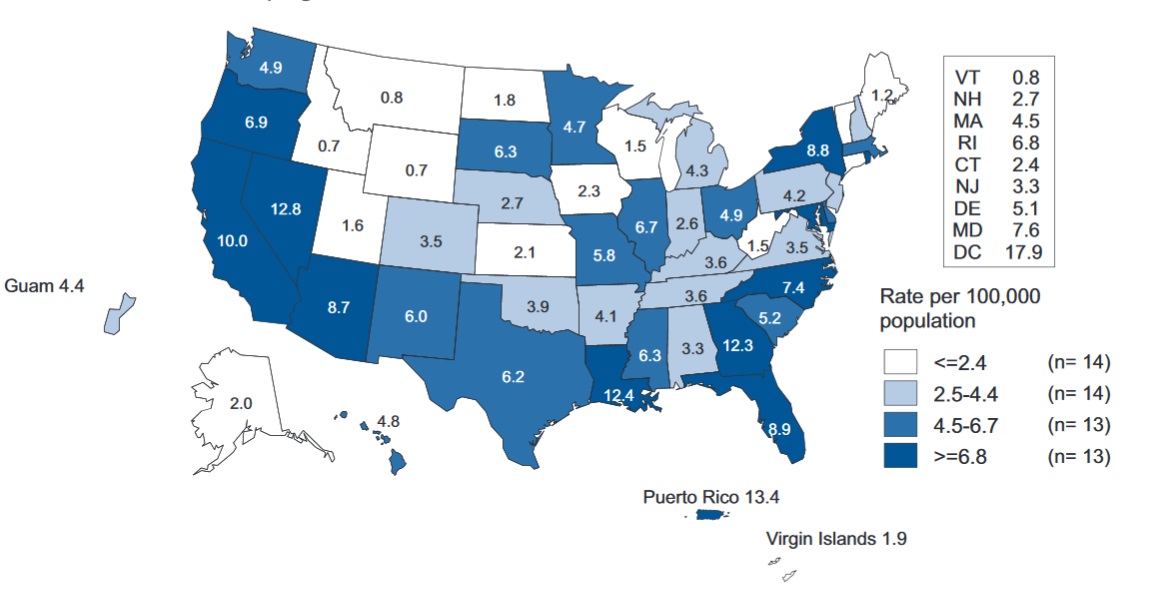
Source: https://www.cdc.gov/
- Rates of reported cases of primary and secondary syphilis by region for 2014 is shown in the map below:
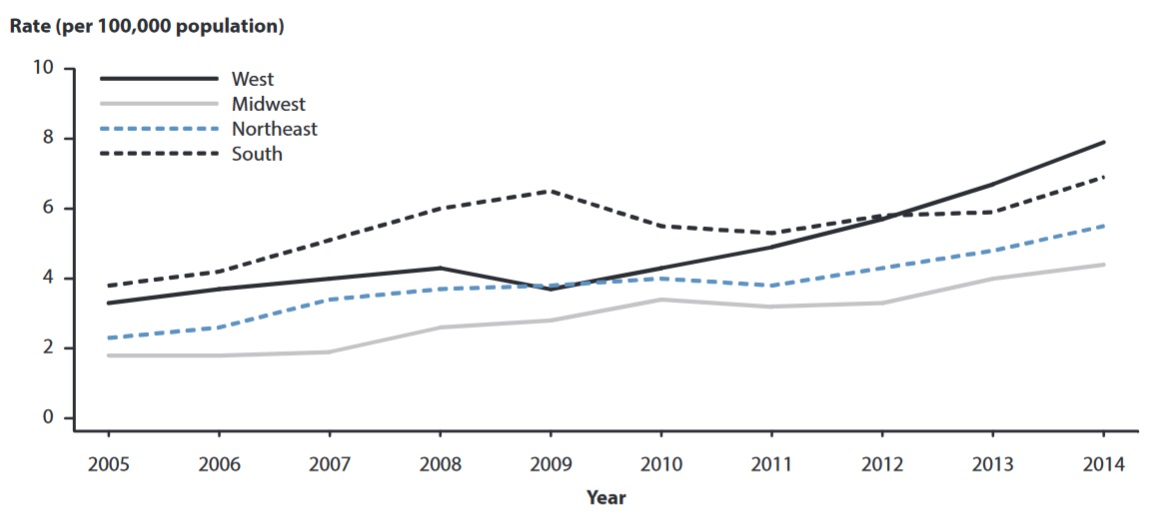
Source: https://www.cdc.gov/
References
- ↑ 1.0 1.1 1.2 1.3 1.4 1.5 1.6 1.7 https://www.cdc.gov/std/stats14/surv-2014-print.pdf Accessed on September 16, 2016
- ↑ 2.0 2.1 2.2 2.3 2.4 Newman L, Rowley J, Vander Hoorn S, Wijesooriya NS, Unemo M, Low N; et al. (2015). "Global Estimates of the Prevalence and Incidence of Four Curable Sexually Transmitted Infections in 2012 Based on Systematic Review and Global Reporting". PLoS One. 10 (12): e0143304. doi:10.1371/journal.pone.0143304. PMC 4672879. PMID 26646541.
- ↑ 3.0 3.1 Satterwhite CL, Torrone E, Meites E, Dunne EF, Mahajan R, Ocfemia MC; et al. (2013). "Sexually transmitted infections among US women and men: prevalence and incidence estimates, 2008". Sex Transm Dis. 40 (3): 187–93. doi:10.1097/OLQ.0b013e318286bb53. PMID 23403598.
- ↑ 4.0 4.1 4.2 http://apps.who.int/iris/bitstream/10665/85376/1/9789241505895_eng.pdf?=1 Accessed on September 16, 2016
- ↑ 5.0 5.1 Purcell DW, Johnson CH, Lansky A, Prejean J, Stein R, Denning P; et al. (2012). "Estimating the population size of men who have sex with men in the United States to obtain HIV and syphilis rates". Open AIDS J. 6: 98–107. doi:10.2174/1874613601206010098. PMC 3462414. PMID 23049658.
- ↑ 6.0 6.1 Heffelfinger JD, Swint EB, Berman SM, Weinstock HS (2007). "Trends in primary and secondary syphilis among men who have sex with men in the United States". Am J Public Health. 97 (6): 1076–83. doi:10.2105/AJPH.2005.070417. PMC 1874206. PMID 17463387.
- ↑ 7.0 7.1 Judson FN, Penley KA, Robinson ME, Smith JK (1980). "Comparative prevalence rates of sexually transmitted diseases in heterosexual and homosexual men". Am J Epidemiol. 112 (6): 836–43. PMID 6893897.
- ↑ Hook EW, Peeling RW (2004). "Syphilis control--a continuing challenge". N Engl J Med. 351 (2): 122–4. doi:10.1056/NEJMp048126. PMID 15247352.
- ↑ 9.0 9.1 http://apps.who.int/iris/bitstream/10665/75181/1/9789241503839_eng.pdf Accessed on September 16, 2016
- ↑ Herbert LJ, Middleton SI (2012). "An estimate of syphilis incidence in Eastern Europe". J Glob Health. 2 (1): 010402. doi:10.7189/jogh.02.010402. PMC 3484754. PMID 23198131.
- ↑ Kenyon CR, Osbak K, Tsoumanis A (2016). "The Global Epidemiology of Syphilis in the Past Century - A Systematic Review Based on Antenatal Syphilis Prevalence". PLoS Negl Trop Dis. 10 (5): e0004711. doi:10.1371/journal.pntd.0004711. PMC 4864207. PMID 27167068.